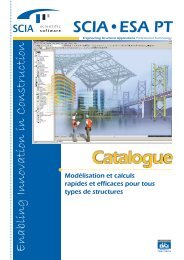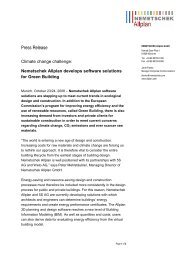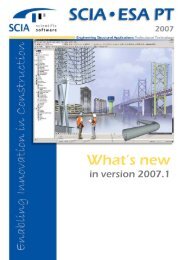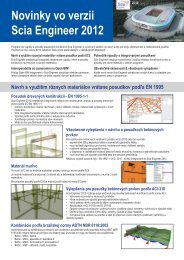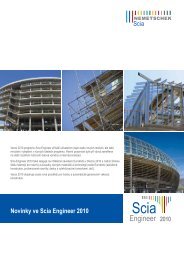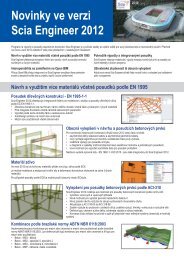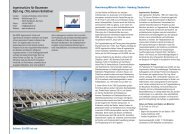VSH Turòa nad Bodvou - Nemetschek Scia
VSH Turòa nad Bodvou - Nemetschek Scia
VSH Turòa nad Bodvou - Nemetschek Scia
Create successful ePaper yourself
Turn your PDF publications into a flip-book with our unique Google optimized e-Paper software.
Introduction<br />
The aim of this project was to prove that the internal structure of a<br />
luxury yacht would be strong enough to support the cradle forces<br />
exerted on the yacht as it was transported out of the production<br />
hall and onto the ship lift.<br />
The main concern in this case was that usually the cradles are placed<br />
directly under the transverse bulkheads of the vessel; in this case<br />
however the forward cradles would have to be placed between<br />
the bulkheads to facilitate access to the ship lift. This resulted in a<br />
large force being introduced into the vessel on a very local scale if<br />
compared to the normal situation of the vessel in water.<br />
Method of analysis<br />
This project determined the resulting stresses in the vessel due to<br />
the cradle being positioned between the bulkheads 65 and 80.<br />
The calculation covers all stresses occurring in the structure due to<br />
the introduced cradle load. The fore part of the ship was built up of<br />
mainly plates without additional stiffening. The reason for this was<br />
if could be shown that the main plate fields without the additional<br />
stiffening could support the introduced load. It can be concluded<br />
that the stiffened structure will meet the requirements. This results<br />
in the shell being modelled excluding the stiffeners. This approach<br />
has been chosen in order to ensure that the stress levels remain<br />
within the allowable limits.<br />
SCIA•ESA PT allows the modelling of accurate models of curved<br />
plates. They are created in order to determine deformations and<br />
internal stresses. This delivers accurate results since the interaction<br />
between the various plating and beams is taken into<br />
consideration.<br />
The modelled section of the vessel, from frames 65 to 80, was<br />
supported by fixed line supports along the entire edge of the bulkheads.<br />
Thus basically the section was pinned between the bulkheads<br />
and then forced to bend under the introduced load. This is<br />
a very conservative approach since the section is not actually fixed<br />
between the bulkheads. However this approach was taken to<br />
ensure that the calculated stresses would also be on the conservative<br />
side.<br />
Only one side, namely the starboard side, of the forward section<br />
was modelled. Since the vessel is symmetrical, it was sufficient to<br />
model only one side.<br />
Rules and Regulations<br />
The following rules and regulations were used to complete the<br />
check of the internal structures of the vessel:<br />
• Lloyd’s Register Rules and Regulations<br />
• Rules and Regulations for the Classification of Special Service<br />
Craft, July 2003, incorporating Notices No. 1 and 2<br />
• Part 6 Hull Construction in Steel<br />
Yacht on transport cradles - Analyisis of internal structure<br />
Loads<br />
The load exerted onto the vessel was determined by using the<br />
maximum capacity of the Mammoet load liners used to transport<br />
the vessel. These load liners would be lifting the large cradles on<br />
which the entire weight of the vessel would be resting.<br />
Basically the entire vessel would be supported on 4 cradles, with<br />
2 supports points each, one on the port side and one on the starboard<br />
side. Between the steel of the cradle and the steel hull, a<br />
layer of wood was used to attempt to reduce the “hard point” of<br />
the load.<br />
A load of 176 tons had to be introduced into the vessel between<br />
frames 65 and 80. The support area was 3,0m by 1,8m, resulting in<br />
a surface area of roughly 290kN/m2 .<br />
Results<br />
The results proved that the vessel would be able to support the<br />
introduced cradle loads between the bulkheads without any modifications<br />
to the vessel. The conservative approach ensured that the<br />
actual deflections and stresses that occurred during the transport<br />
did not have any adverse effect on the yacht.<br />
213




